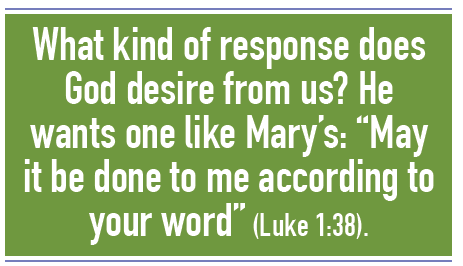
BY WILLIAM O’LEARY
Moral formation of children and young people
Finish this statement: “Catholicism is just a bunch of __________.” I am willing to guess that almost 99 percent of you chose the word rules. That is often what many Christians and non-Christians think of when describing morality. Since the Enlightenment (in the 17th century), we have downgraded morality to a list of ethical principles or a set of proper behaviors. However, there is much more to morality than merely a list of what is right and wrong.
Formation grounded in love
Every day, as my twin brother and I would leave the house, whether it was going to school or going down the street to a friend’s house, we would hear these words: “And remember, Mommy loves you!” Even if the day before we had put mud and toothpaste on the dog and Mom had to wash her multiple times, or if we had broken one of her favorite glass bowls, she always echoed those words. Clearly this love was not rooted in what we did, but in who we were — her children that she loved in both good moments and infuriating ones. This example models the starting point of the moral formation — a relationship.

The third section of the Catechism of the Catholic Church opens with this:
“Christian, recognize your dignity and, now that you share in God’s own nature, do not return to your former base condition by sinning. Remember who is your head and of whose body you are a member. Never forget that you have been rescued from the power of darkness and brought into the light of the Kingdom of God” (CCC, 1691).
Our dignity is grounded in being adopted children of God, who loves us beyond our wildest imaginings. Children and adults need to discover (or rediscover) that the foundation of our life in Christ is not whether we are doing good or not; it is rooted in the love of God which has been poured out into our lives. This invitation begins with his total and free gift of love received in Baptism with the promise of a heavenly inheritance. While we were still yet sinners, Jesus died for us simply because he loves us — totally, freely, and completely (see Romans 5:8).
A moral formation is laid through the foundation of love experienced by the child. Sofia Cavalletti and Gianna Gobbi, founders of the Catechesis of the Good Shepherd, wrote: “To teach morality [a person] must be convinced that at its root is love, and then proceed from that principle. Morality emerges from love” (Teaching Doctrine and Liturgy, p. 110).
Responding to love with love
Recall Matthew’s Gospel when Jesus told the story of the two sons. Jesus said:
“What do you think? A man had two sons; and he went to the first and said, ‘Son, go and work in the vineyard today.’ And he answered, ‘I will not’; but afterward he repented and went. And he went to the second and said the same; and he answered, ‘I go, sir,’ but did not go. Which of the two did the will of his father?” They said, “The first” (Matthew 21:28-31).
The Gospel invites the children of God to yield to the will of God out of love for him.
Therefore, the second aspect of moral formation is our response to God’s invitation of love and salvation. The Catechism teaches:
The way of Christ “leads to life”; a contrary way “leads to destruction.” The Gospel parable of the two ways remains ever present in the catechesis of the Church; it shows the importance of moral decisions for our salvation: “There are two ways, the one of life, the other of death; but between the two, there is a great difference” (CCC, 1696).
Each of us is called to respond to this gift of love according to God’s revelation of himself. Through his revelation in Sacred Scripture and Tradition, he has shown us the way to life and cautioned us to avoid the ways which are contrary to that life. He invites us and then waits for us to respond.

What kind of response does God desire? He wants one like Mary’s: “May it be done to me according to your word” (Luke 1:38). Or like Peter’s: “Master, to whom shall we go? You have the words of eternal life” (John 6:68). He wants the response of the Good Samaritan who concretely loved his neighbor. Or a heartfelt response like St. Thérèse of Lisieux when she replied to what God offered her: “I choose all.” These are the responses Jesus desires from his disciples.
Teaching moral formation to children (by age)
Ages: 0-6
The task of moral formation in children involves the body, heart, and mind. Without all three aspects, the formation of morality in children (and adults, for that matter) is stunted and incomplete.
Maria Montessori, an influential educator in the 20th century, understood that moral formation begins with the body in children; she established this in activities called “practical life.” These activities developed in younger children an awareness of how to care for their environment and foster self-discipline as the basis for moral action. Some examples include cleaning up after themselves, tidying their table, or pouring beans from one bowl to another without spilling. These activities and others like them help a child focus on fostering order and what Montessori called physically “habituated” activities. The more the child “habituates” these activities, although they are not of the age to rationally understand what they are doing, the more the child acts out what they have habitually done.
The practice of self-discipline assists a child’s growth in moral formation. In addition, it is rooted in an awareness that I am called by name by Jesus, the Good Shepherd who loves me. Joy and love are the dominant responses of young children who discover and live in this reality.
Ages: 6-12
At the beginning of this phase of development, it is essential to continue fostering the awareness in children that they are loved by someone who calls them by name and cares for them. In addition, they become more aware of their environment and begin to see themselves in relation to the places and things around them in the context of time and space. They continue the self-mastery process assisted by practical life activities as mentioned above — specifically the liturgical seasons of Advent and Lent during which they practice acts of penance.
Ages: 12-18
Children at this age continue to ask questions about how living a moral life fits into living in this world. They are hungry for witnesses who are living out their faith. They also need reminders of the virtues and the saints. In a world that promotes doing what feels good and practices little self-discipline, we must not only reinforce the points mentioned in the previous age group, but help teens see and understand the true benefits to that living a moral life provides.
The moral life is about a relationship that captivates us and beckons us to respond. St. Paul said it so well: “For the love of Christ impels us” (2 Corinthians 5:14, emphasis added). A moral life rooted in a relationship with Christ is the goal.
***
Resources for Moral Formation
The Bible
Scripture is always a reliable means of engaging the heart of a child for God — especially the parables. Two categories are significant for children: the parables of mercy and the moral parables. Begin with the Healing of a Centurion’s Servant (see Matthew 8:5-13), and two parables of mercy — The Lost Coin (Luke 15:8-10) and The Parable of the Lost Son (Luke 15:11-24). These examples illustrate the foundation of love as the basis for moral behavior.
Other parables that help guide behavior:
Use these with ages 6-9: The Parable of the Good Samaritan (Luke 10:29-37), The Parable of the Pharisee and the Tax Collector (Luke 18:9-14), The Persistent Friend (Luke 11:5-8), The Parable of the Dishonest Steward (Luke 16:1-13), and The Parable of the Sower (Luke 8:4-15). Expand with ages 9-12 by teaching The Parable of the Ten Virgins, The Parable of the Talents (Matthew 25:1-12; 14-30), and The Wedding Feast (Matthew 22:1-14).
Consider using these parables in lessons involving making good decisions, God’s mercy and forgiveness, the great commandment, and the commandments in general.
Training in the virtues
Teach children to foster virtue (the habit of doing good) in their lives. For parents and educators: Disciple of Christ — Education in Virtue was developed by the Dominican Sisters of Mary, Mother of the Eucharist in Michigan. Visit EducationInVirtue.com.
K4J.org fosters virtues and faith in the family.
PACE is the Program for Achieving Character Education. Go to CatholicPace.com.
William O’Leary lives in Kansas with his wife and three children. He is the Director of Religious Formation for a large parish in Overland Park, Kansas. Over the last 20 years, his work in pastoral ministry has explored ways to draw parents and their children into the practice of their faith. His blog is RelevantCatechesis.com.
Image credit: IMAGE COMPOSITED FROM SHUTTERSTOCK IMAGES BY: OLLYY, KRIVOSHEEV VITALY, TTSTUDIO, ANDREW FLETCHER




